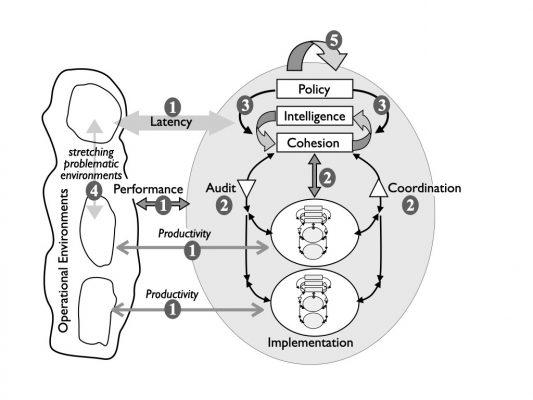
The governance relationships in the above figure are explained below.
The numbers in this figure are the same as the numbers in
the paragraphs that follow:
- Relationship of performance, productivity and latency
take place between actors striving for innovation and producing products, services and externalities with external stakeholders or agents. These actors constitute the productivity relationship through policy implementation and latency relationship through actors constituting the intelligence relationships concerned with
the outside and then of the organizational system. The latter are relationships in which organisational actors are stretched by stakeholders in the problematic environment. These relationships may be controlled in one extreme by greedy lobbyists, vociferous unrepresentative minorities and conservative bureaucrats or in a more favourable perspective by the viewpoints of empowered autonomous actors, enlightened entrepreneurs and innovative bureaucracies. This stretching put pressure on both policy makers to invent new responses to changes in the status quo and on stakeholders to recognize their responsibility in triggering this change. - Relationship of cohesion between all the actors constituting the organization (e.g. policy makers, experts, civil servants, administrators, employees within the primary
activities); in the extreme these relationships can be governed by the authoritarian tendencies of those in power, imposing hierarchical relationships, or by the mutual respect among all actors that enables autonomy within a cohesive organization, that is, enable heterarchical relationships. These variety operators could be processes such as actors’ coordination of actions with others, their collaboration and
solidarity, trust building within the situation and others. - Relationship of Policy Making, between policy makers and those actors focused on the outside and then, (intelligence actors) and those actors focused on the inside and now (cohesion actors within the organisational system). Policymakers’ role is to orchestrate conversations between both viewpoints and based on the leadership of desirable purposes and values, they should recognise which conversations are necessary to create robust policies. A key role of policy makers is working out who are these relevant people that should participate in policy debates.
- Relationship of Inclusion between policy makers and the owners of the organizational system, that is, the people to whom these policy makers are accountable; as President Allende said in the case of Cybersyn these stakeholders were the People. In particular, these are relationships of inclusion
and legitimacy which suggest a relationship of social ownership of the organizational system. - Relationship of organizational citizenship between the organizational actors and those providing normative context to their activities, for example, those in society who are guardians of societal values. These are the self-developing reflexive environments, constituted among others by meta systemic regulators of the organisational system. These are the meta-systemic operators constituting the variety operators in between management, organisational system and
environment. - The overall relationship between the organizational system and stakeholders is the relationship of performance (1), which is constituted by the intertwining of the relationships of productivity and latency. Through the relationships of policy (3) stakeholders influence the identity of the organizational system as they elect representatives that reflect their purposes and values. For a more direct influence of the problematic environment in the relationship 4 of the above figure these external stakeholders can directly leverage their power, firstly through their moment-to-moment communications with stakeholders in the system’s operational environment (4), who are in productivity relationships (1) with those producing this system and secondly through their dialogues and other forms of engagement with the system’s intelligence actors responsible for its latency through the stretching relationship (1).
